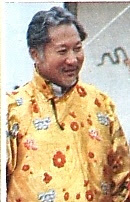OSU FAVOURS ST STATUS FOR
ALL SIKKIMESE
“Distinct Identity Within
The Union”
Though it has not yet taken a formal decision on the issue, the Organisation of Sikkimese Unity (OSU) has taken a serious note of the demand for Scheduled Tribes status to all bonafide Sikkimese belonging to the three ethnic communities in the State who were genuine subjects of the erstwhile kingdom.
Presently, only the minority Bhutia-Lepchas
have been enlisted in the Scheduled Tribes list as per the Scheduled Tribes
Order of 1978. The inclusion of all former ‘Sikkim Subjects’ belonging to the
three ethnic groups of Lepchas, Bhutias and Nepalese in the State’s ST list
will not only ensure peace, unity and harmony in the State but will also go a
long way in improving the economic and educational welfare of bonafide
Sikkimese.
The division among Sikkimese Nepalese on caste lines not only affects political stability in the State but also endangers national security in this sensitive region. The need to restore peace, harmony and unity along the Sikkimese is the need of the day. The OSU believes that forces of disunity will hamper preservation of Sikkim’s ‘distinct identity within the Union.’
Though the OSU favours ST status to all bonafide Sikkimese, irrespective of caste and community, it is firm on political rights concerning restoration of Assembly seats to the Sikkimese. While the OSU may prefer economic benefits and facilities to be enjoyed by all STs in the State it wants seats in the Assembly to be reserved solely for the Sikkimese on the basis of them belonging to the three ethnic groups and not on the basis of them being scheduled tribes.
This is aimed at preserving the distinct identity of the Sikkimese as per the terms of the merger and Article 371F of the Constitution, which reflects provisions of the May 8 Tripartite Agreement of 1973 and Government of Sikkim Act of 1974.
The Sikkim Newar Guthi (SNG), headed by the
former Chief Secretary, Keshav Chandra Pradhan, as its President, recently
urged the Sikkim Bhutia-Lepcha Apex Committee (SIBLAC) to demand inclusion of
all Sikkimese in the list of Scheduled Tribes in the State. Pradhan believes
that declaration of all Sikkimese in the list of STs in the State will “reweave
the fine Sikkimese fabric and bring about a trust, amity and goodwill among all
sections of the community so vital in this sensitive border State.”
In his letter, dated Sept 6 1999, to the
SIBLAC Convenor, Pradhan pointed out that mutual trust and harmony in the State
“was in fact the basic spirit and objective behind the Article 371F when it was
initially framed.” Though SIBLAC has not yet responded to the Guthi’s
initiative the OSU has taken the matter seriously and will soon take a firm
decision on this issue. It must be noted that while other social organizations
kept mum, choosing to take sides with political parties during the recent
elections, the Guthi took a principled stand and openly supported SIBLAC’s
demand for restoration of the political rights of the minority Bhutia-Lepchas in
the State.
In response to the appeal made by SIBLAC on the seat issue, OSU leaders helped to form the Sikkimese Nepalese Apex Committee (SNAC). The OSU feels that the seat issue should now be fought jointly by both the minority and majority communities.
(Ref: Sikkim Observer, 30 October 1999, Sikkim For Sikkimese: Distinct Identity Within The Union, Jigme N. Kazi, Hill Media Publications, Gangtok, 2009)






























